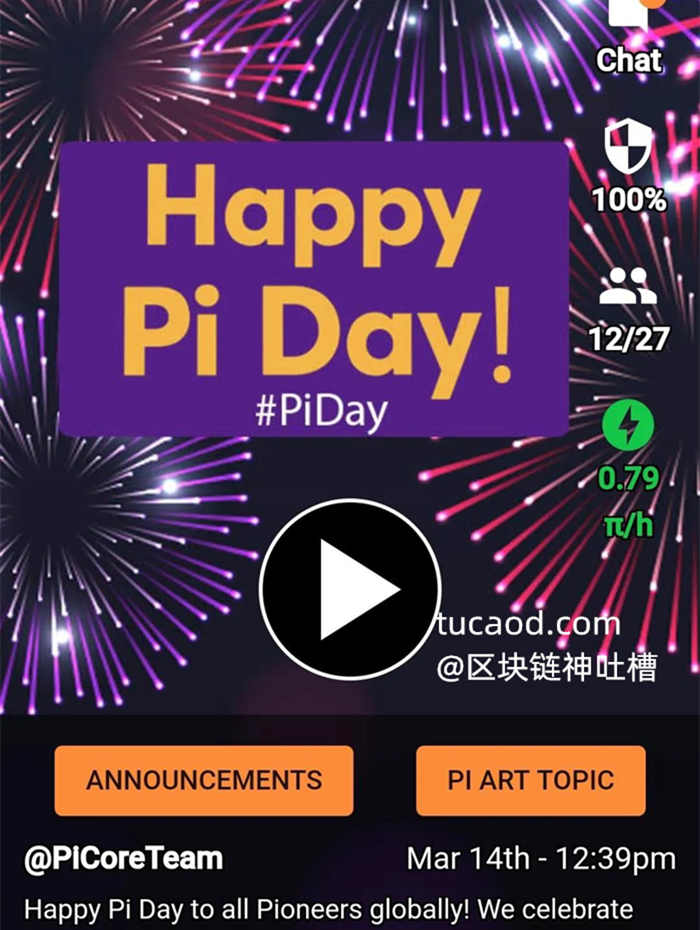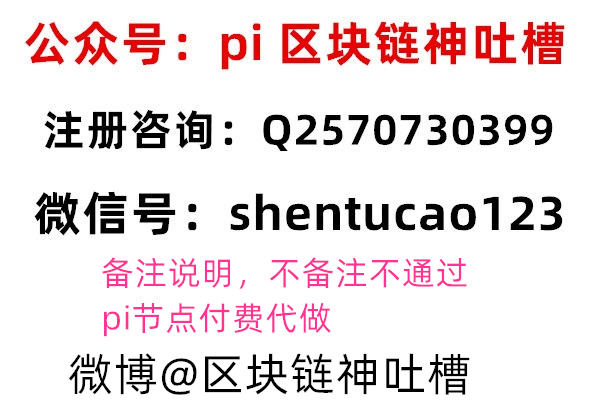神吐槽:pi官方在国外新闻网站 Bitcoinist 发了一篇文章,介绍 PiNetwork 项目。按照国内的说法,就是发了一个软文宣传项目也就几百元营销费,请勿大惊小怪过度解读。
加密新闻出版物 Bitcoinist 在一篇概述 Pi 的技术和目标的文章中介绍了 Pi。 对于那些不熟悉 Pi 和加密技术的人来说,这是一个很好的介绍性资源。 随意将这篇文章链接到您的网站/博客或在社交媒体上与您的朋友分享,以帮助更多人了解 Pi。
@PiCoreTeam Jun 16th - 10:27am
Crypto-news publication Bitcoinist featured Pi in an article that outlines Pi’s technology and goals. It’s a great introductory resource for those unfamiliar with Pi and crypto technology. Feel free to link this article on your website/blog or share it with your friends on social media to help more people understand Pi.
国外网站链接地址(不需要科学上网就可以看到):
https://bitcoinist.com/introducing-pi-network-making-cryptocurrency-accessible-to-the-masses/
以下是英文翻译:
在比特币和第一代加密货币的早期,任何人都可以使用任何基本的计算设置来挖掘硬币。直到 2013 年左右,您所需要的只是一个标准 GPU。然而,随着比特币价值的上涨和更多矿工进入该领域,加密货币挖掘变得越来越具有竞争力,以至于现在需要专门用于挖掘任务的专业硬件。
如今,普通人不再能够进行加密挖掘。比特大陆实际上垄断了挖矿设备的供应,只有六个矿池主导了大部分 BTC 挖矿活动,前三名控制了 50%。采矿活动通常如此集中,以至于中国局部停电可能导致市场崩盘。
神吐槽:这里是有点夸大比特币矿池的作用了,原文的意思是想说明比特币逐渐中心化了。事实是比特币依靠全节点来捍卫自由,而不是靠矿池。
随着加密货币变得更加制度化,比特币和其他主要山寨币的开采只会继续集中化。然而,让大众可以使用加密货币,尤其是挖矿是 Pi 的目标,Pi 是一项由两位拥有斯坦福大学博士学位的创始人带头发起的区块链计划。在计算机科学和社会科学。

什么是圆周率派币PiNetwork?
Pi 的构想是重新民主化对加密货币的访问,并使任何人都可以使用易于获得的设备(智能手机)进行挖矿。
该项目通过使用由 恒星币 Stellar 区块链背后的科学家设计的联邦拜占庭协议 (FBA) 的变体来实现这一点。pow工作量证明和pos权益证明的许多变体依赖于一个矿工或验证者通过提出一个共识块来成为“领导者”的想法,而 FBA 使用不同的方法运作。
这种共识模型不是提名领导者,而是取决于节点通过一系列投票通过交换消息就特定块达成共识。使用这种机制达成共识的一种广为人知的算法是拜占庭容错(BFT),它在各种区块链中实现,包括 Ripple、Hyperledger Fabric 和 Zilliqa。然而,对 BFT 共识模型的一个批评是,它们有一个中心化点,因为系统创建者在创世时集中确定了参与投票法定人数的节点集。
为了克服中心化风险,Pi 使用了 FBA 的附加层,允许每个节点以去中心化的方式设置自己的“仲裁片”。此功能使节点能够自行确定是否信任其他节点,而不是依赖中央机构来这样做。
由于投票涉及的消息传递相对轻量级,特别是与pow工作量证明相比,Pi 的共识算法消耗的能量非常少。
神吐槽:这段说的是,pi币挖矿 对比 比特币挖矿 省电。详情可以看这篇文章《pi网络 PiNetwork 可持续发展绿色环保区块链 》
如何挖掘 Pi币
用户可以通过将 Pi Network 应用程序下载到他们的智能手机来参与挖掘 Pi。然后,他们最多可以在 Pi 共识中扮演四个角色:
- 先锋是移动应用程序的用户,他们在每次登录时只需验证他们的存在。他们的贡献是使 Pi Network 广泛分布。目前,他们只能通过他们的 Pi 钱包在 Pi Testnet 上发送和接收 Test-Pi。
- 贡献者是提供他们认识和信任的先驱者列表并保持该列表更新的用户。最终,贡献者正在帮助开发 Pi 共识所需的全局信任图。
- 大使是将他人介绍给 Pi 网络的用户。
- Nodes 是先驱者和贡献者,他们也在台式机或笔记本电脑上运行 Pi 节点软件。 Pi 节点执行运行区块链共识算法的繁重工作,并将使用从移动贡献者提供的可信先驱者那里聚合的信任图。
神吐槽:目前只能每天手机点一次,节点、大使、贡献者、先锋都是一个意思。官方也强调了,说能交易的是骗子。
参与者可以扮演多个角色。每天,他们都会根据他们的参与和贡献获得新铸造的 Pi。
Pi 的当前值表示为零。 Pi 背后的团队认为,可以通过创建加密货币的实用程序来实现价值,人们使用 Pi 在全球范围内进行大规模的商品和服务交易。这些商品和服务最终将支持 Pi 的价值。
实名认证KYC 和隐私
为了维护网络的完整性,Pi 实施了 KYC 政策。用户必须通过其 ID 副本进行验证才能将 Pi 转移到 Pi 主网区块链中。这可以防止用户尝试操作多个帐户或运行机器人或农场等滥用系统。这也意味着 Pi 正在成长为第一个也是最大的经过验证的网络之一。
Pi Network 目前使用受信任的第三方供应商来保护 KYC 流程和数据。公司承诺根据其隐私政策确保用户数据安全,并承诺不出售或以其他方式滥用用户 KYC 数据。
神吐槽:目前KYC没用,感兴趣可以看这个《Pi币申请 kyc 认证实名教程》。
pi发展和路线图
Pi自2018年开始开发,目前项目处于testnet模式。 Pi 测试网是一个可公开访问的系统,拥有超过 10,000 个连接的稳定活跃节点,一旦其主网启动,这将使其成为世界上最大、最强大的分布式网络之一。要参与 Pi 测试网,用户可以从他们的网站 node.minepi.com 下载 Pi 桌面软件 Pi Node,并通过现有的 Pi 移动应用程序帐户参与。 .
该网络将继续在测试网中运行,直到大约 2021 年底,之后它将在主网上启动。
同时,Pi 团队也在构建 Pi Utilities 平台,以支持 Pi 生态系统,整个网络都可以在其中做出贡献并构建产生价值的路径。该项目最近发布了其 2021 年第二季度公用事业平台的最新更新和计划,包括与 Pi 测试网的平台集成,允许第三方 Pi 应用程序请求用户的 Pi 钱包交易并在测试网上进行交易。当 Pi 的主网上线时,这些功能将允许 Pi 用户在基于 Pi 的应用程序中使用他们的 Pi 代币。 Pi 浏览器是 Pi Network 于 2021 年 3 月推出的另一个移动应用程序,也将与公用事业平台集成。从开发人员的角度来看,该团队正在开发一个新的开发人员门户和标准化环境,以构建和部署生态系统应用程序。
神吐槽:主网启动,也不代表你能卖币,你能一夜暴富。好好工作上班,比什么都重要。
感兴趣可以看这个《pi币真的可以值钱卖钱成功吗?手机挖矿挣钱是什么原理?100万个pi币纪念文章》
公平地说,Pi 正在采用“缓慢而稳定”的方法在主网上启动,与许多其他平台相比,这有悖常理。这样做的原因是该项目正在使用 Beta 版与社区成员和开发人员一起迭代和改进协议,同时围绕货币开发其生态系统和社区以引导经济。这个想法是,到主网启动时,已经建立了一个对产品和应用程序生态系统感到满意的网络。 Pi 已经在 238 个国家/地区以 52 种语言开展业务。
团队
Pi 由 Nicolas Kokkalis 博士和范程调博士创立。 Kokkalis 博士拥有博士学位。来自斯坦福大学,是斯坦福大学第一堂去中心化应用课程的讲师,每年在斯坦福大学共同教授超越比特币课程。在教授 dapps 课程的过程中,他意识到将区块链技术提供给普通人的难度。
范博士拥有博士学位。斯坦福大学计算人类学博士。她的研究重点是人机交互和社会计算——我们如何利用技术对人类行为和社会产生积极影响。
Pi 团队共有 14 人,在全球范围内工作。
结论
目前,大多数主要加密货币的进入门槛非常高,以至于大多数参与者都被排除在外。 在智能手机上挖掘 Pi 是一种观看加密货币奖励每天累积的简单方法。
然而,这些奖励的价值需要 Pi 获得网络效应的牵引力和使用。 只有当有足够多的人参与并愿意在 Pi 中交易商品和服务时,奖励才会获得任何现实世界的价值。 从这个意义上说,Pi 的成功取决于它能够接触到足够多的人和足够的实用程序。
如果该项目能够应对这一挑战,那么 Pi 在主网上启动时就很有可能取得成功。
In the earliest days of Bitcoin and first-generation cryptocurrencies, anyone could mine coins using any basic computing setup. Until around 2013, all you needed was a standard GPU. However, as the value of Bitcoin rose and more miners entered the space, cryptocurrency mining became ever more competitive, to the point where it now requires specialist hardware dedicated to the task of mining.
These days, crypto mining is no longer accessible to the average person. Bitmain has a de facto monopoly over the supply of mining equipment, and just six mining pools dominate the majority of BTC mining activity, with the top three controlling 50%. Mining activity is often so concentrated that a localized power outage in China can precipitate a market crash.
Predict the price of BTC & AAB and win up to 5,000 USDT!
As cryptocurrency becomes more institutionalized, mining Bitcoin and other major altcoins will only continue to centralize. However, making cryptocurrencies, and mining in particular, accessible to the masses is the aim of Pi, a blockchain initiative spearheaded by two founders with a Stanford Ph.D. in Computer Science and Social Sciences.
What is Pi?
Pi was conceived with the vision of re-democratizing access to cryptocurrencies and making them accessible for anyone to mine with equipment that’s easily available – a smartphone.
The project achieves this by using a variation of the Federated Byzantine Agreement (FBA), devised by the scientists behind the Stellar blockchain. Whereas proof of work and the many variations on proof of stake rely on the idea of one miner or validator becoming the “leader” by proposing a block for consensus, the FBA operates using a different approach.
5 BTC + 300 Free Spins for new players & 15 BTC + 35.000 Free Spins every month, only at mBitcasino. Play Now!
Rather than nominating a leader, this consensus model depends on nodes reaching consensus over a particular block through a series of voting through exchanging messages. A widely known type of algorithm that uses such a mechanism to reach consensus is Byzantine Fault Tolerance (BFT), which is implemented in various blockchains, including Ripple, Hyperledger Fabric, and Zilliqa. However, one criticism of BFT consensus models in general is that they have a point of centralization because the system creator centrally determines the set of nodes participating in the voting quorum at genesis.
To overcome the centralization risk, Pi uses the additional layer of FBA which allows each node to set their own “quorum slices” in a decentralized manner. This feature enables nodes to determine for themselves whether or not to trust other nodes, rather than relying on a central authority to do so.
Because the messaging involved in voting is relatively lightweight, particularly compared to proof of work, Pi’s consensus algorithm consumes very little energy.
How to Mine Pi
Users can participate in mining Pi by downloading the Pi Network app to their smartphone. Then, they can play up to four roles in the Pi consensus:
Pioneers are users of the mobile app who simply validate their presence each time they log in. Their contribution is in making Pi Network widely distributed. Currently, they can send and receive only Test-Pi on Pi Testnet through their Pi wallets.
Contributors are users who provide a list of pioneers they know and trust and maintain this list up to date. Ultimately, contributors are helping to develop the global trust graph needed for Pi’s consensus.
Ambassadors are users who introduce others to the Pi network.
Nodes are pioneers and contributors who also run the Pi node software on a desktop or laptop computer. Pi Nodes perform the heavy lifting of running the consensus algorithm of the blockchain and will use the trust graph aggregated from the trusted pioneers provided by mobile contributors
Participants can play more than one role. Each day, they receive newly minted Pi based on their participation and contribution.
The current value of Pi is stated as zero. The team behind Pi believes that value can be realized through the creation of utilities of the cryptocurrency where people use Pi to transact goods and services at scale globally. These goods and services will ultimately back the value of Pi.
KYC and Privacy
To maintain the integrity of the network, Pi operates a KYC policy. Users must be verified with a copy of their ID to be able to transfer Pi into the Pi Mainnet blockchain. This prevents any abuse of the system by users attempting to operate multiple accounts or run bots, or farms, etc. It also means that Pi is growing to become one of the first and largest verified networks.
Pi Network currently uses a trusted third-party vendor to secure the KYC process and data. The company commits to keeping user data safe per its privacy policy and undertakes not to sell or otherwise abuse user KYC data.
Developments and Roadmap
Pi has been in development since 2018. Currently, the project is in testnet mode. The Pi Testnet, a publicly accessible system, has over 10,000 nodes connected with stable liveness, which will make it one of the largest and most powerful distributed networks in the world once its Mainnet launches. To participate in the Pi Testnet, users can download the Pi desktop software Pi Node from their website node.minepi.com and participate through an existing Pi mobile app account. .
The network will continue to operate in testnet until roughly the end of 2021, after which it will launch on mainnet.
In the meantime, the Pi team is also building its Pi Utilities platform to support the Pi ecosystem, where the whole network can contribute and build the path to generating value. The project recently released its latest updates and plan for its Utilities platform for Q2 of 2021, including platform integration with the Pi Testnet that allows third-party Pi apps to request transactions of users’ Pi wallets and make transactions on the testnet. When Pi’s mainnet goes live, these features will allow Pi users to spend their Pi tokens in Pi-based apps. The Pi Browser, which is another mobile application of Pi Network that launched in March 2021, will also become integrated with the Utilities Platform. From the developer’s standpoint, the team is working on a new developer portal and a standardized environment to build and deploy ecosystem apps.
It’s fair to say that Pi is adopting a “slow and steady” approach to launching on the mainnet, which goes against the grain when compared to many other platforms. The reason for this is that the project is using the Beta launch to iterate and improve on the protocol together with community members and developers while developing its ecosystem and community around the currency to bootstrap an economy. The idea is that by the time the mainnet launches, there will already be an established network happy with the product and ecosystem of apps for use. Pi already operates in 238 countries and 52 languages.
Team
Pi was founded by Dr. Nicolas Kokkalis and Dr. Chengdiao Fan. Dr. Kokkalis holds a Ph.D. from Stanford and was the instructor of Stanford’s first class on decentralized applications, and co-teaches the Beyond Bitcoin class at Stanford once a year. In the course of teaching his dapps class, he came to realize the difficulty of making blockchain technology available to everyday people.
Dr. Fan holds a Ph.D. in Computational Anthropology from Stanford. Her research has focused on human-computer interactions and social computing – how we can use technology to positively impact human behavior and societies.
In total, the Pi team comprises 14 people working around the globe.
Conclusion
The barriers to entry for mining most major cryptocurrencies are currently so high that most participants are excluded. Mining Pi on a smartphone is a simple and easy way to watch cryptocurrency rewards accrue on a daily basis.
However, the value of those rewards requires Pi to gain the traction and usage of the network effect. Only once enough people participate and are willing to transact goods and services in Pi, will the rewards gain any real-world value. In that sense, the success of Pi depends on its ability to reach enough people and enough utilities.
If the project can meet this challenge, Pi has every chance of being a success when it launches on the mainnet.
Pi币代做节点咨询费200元
网页收藏⇒《2021年pi币官方最新消息》
注册教程直接点击(邀请码shentucao123)⇒pi币注册流程全中文图解_手机短信验证@派币 Pi Network官网
更多免费挖矿直接点击⇒手机挖矿app赚钱靠谱https://www.tucaod.com/tag/linglu

 区块链神吐槽
区块链神吐槽